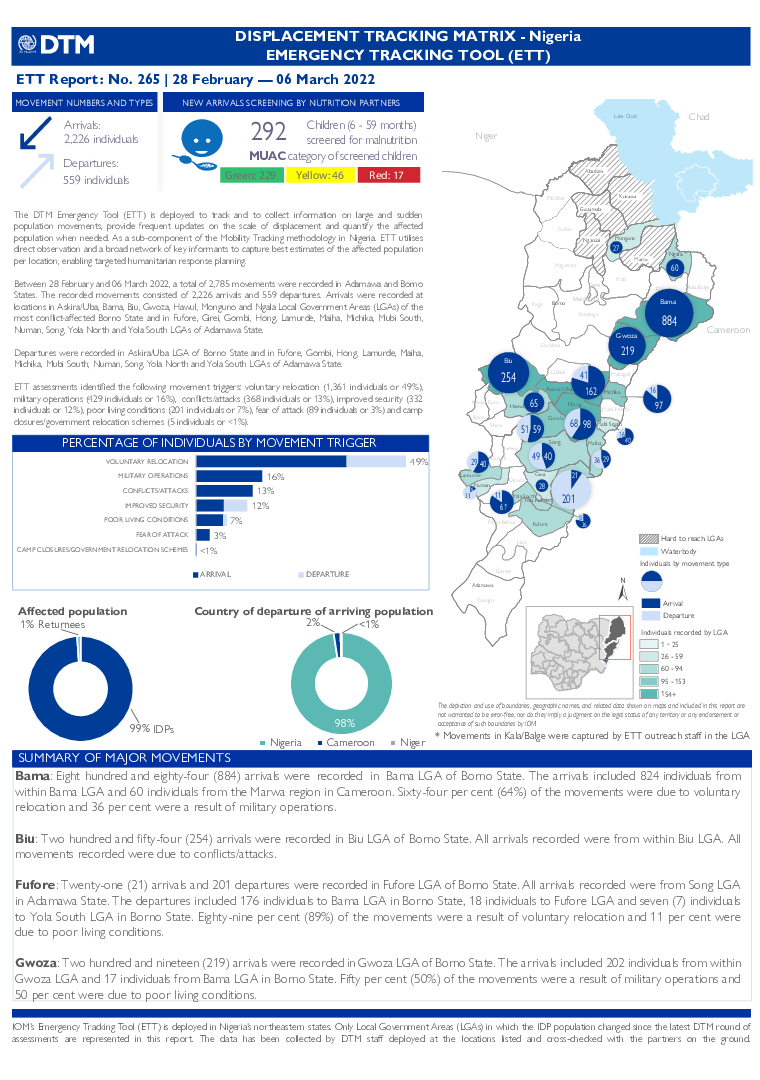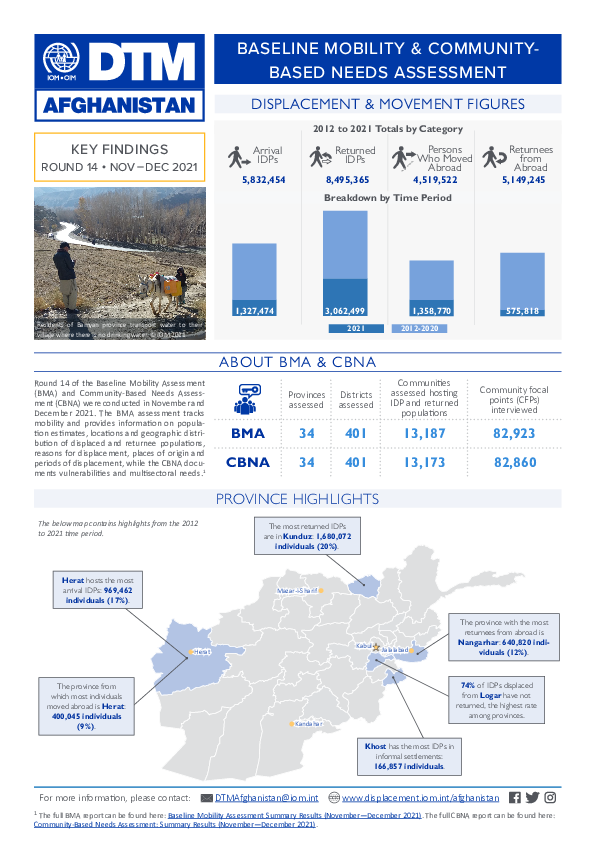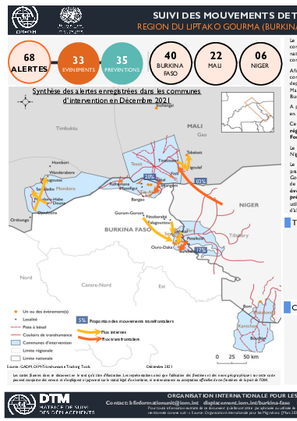-
Countries
-
Data and Analysis
-
Special Focus
-
Crisis Responses

Contact
DTM Nigeria, AllUsersInDTMNigeria@iom.int
Language
English
Location
Nigeria
Period Covered
Feb 28 2022
Mar 06 2022
Activity
- Event Tracking
- Mobility Tracking
The DTM Emergency Tracking Tool (ETT) is deployed to track and to collect information on large and sudden population movements, provide frequent updates on the scale of displacement and quantify the affected population when needed. As a subcomponent of the Mobility Tracking methodology in Nigeria, ETT utilizes direct observation and a broad network of key informants to capture best estimates of the affected population per location, enabling targeted humanitarian response planning.
Between 28 February and 06 March 2022, a total of 2,785 movements were recorded in Adamawa and Borno States. The recorded movements consisted of 2,226 arrivals and 559 departures. Arrivals were recorded at locations in Askira/Uba, Bama, Biu, Gwoza, Hawul, Monguno and Ngala Local Government Areas (LGAs) of the most conflict-affected Borno State and in Fufore, Girei, Gombi, Hong, Lamurde, Maiha, Michika, Mubi South, Numan, Song, Yola North and Yola South LGAs of Adamawa State.
Departures were recorded in Askira/Uba LGA of Borno State and in Fufore, Gombi, Hong, Lamurde, Maiha, Michika, Mubi South, Numan, Song, Yola North and Yola South LGAs of Adamawa State.
ETT assessments identified the following movement triggers: voluntary relocation (1,361 individuals or 49%), military operations (429 individuals or 16%), conflicts/attacks (368 individuals or 13%), improved security (332 individuals or 12%), poor living conditions (201 individuals or 7%), fear of attack (89 individuals or 3%) and camp closures/government relocation schemes (5 individuals or <1%).

Contact
DTM Nigeria, AllUsersInDTMNigeria@iom.int
Language
English
Location
Nigeria
Period Covered
Nov 16 2021
Dec 30 2021
Activity
- Mobility Tracking
- Baseline Assessment
This factsheet presents key findings from the period 16 November to 30 December 2021, this represents the results from the Round 40 of Displacement Tracking Matrix (DTM) assessments carried out by the International Organization for Migration (IOM) in North-east Zone.
During Round 40, DTM identified 2,171,652 IDPs (446,740 households) as well as 1,960,558 Returnees (317,885 households).

Contact
DTM Afghanistan, DTMKabul@iom.int
Language
English
Location
Afghanistan
Period Covered
Nov 01 2021
Dec 31 2021
Activity
- Mobility Tracking
- Baseline Assessment
Round 14 of the Baseline Mobility Assessment (BMA) and Community-Based Needs Assessment (CBNA) were conducted in November and December 2021. The BMA assessment tracks mobility, provide information on population estimates, locations and geographic distribution of displaced, return and migrant populations, reasons for displacement, places of origin and periods of displacement, while the CBNA documents vulnerabilities and multisectoral needs.
The full BMA report can be found here: Baseline Mobility Assessment Summary Results (November—December 2021).
The full CBNA report can be found here:
Community-Based Needs Assessment: Summary Results (November—December 2021).
Contact
SouthSudanDTM@iom.int
Location
South Sudan
Activity
- Flow Monitoring Survey
- Flow Monitoring
Period Covered
Jan 01 2022 -Jan 31 2022
Flow monitoring aims to derive quantitative estimates of the flow of individuals through specific locations and to collect information about the profile, intentions and needs of the people moving and to quantify highly mobile populations by providing a picture of complex mobility dynamics.
Population Groups
Survey Methodology
Unit of Analysis Or Observation
Type of Survey or Assessment
Keywords
Geographical Scope
Administrative boundaries with available data
The current dataset covers the following administrative boundaries
Contact
SouthSudanDTM@iom.int
Location
South Sudan
Activity
- Flow Monitoring Survey
- Flow Monitoring
Period Covered
Dec 01 2021 -Dec 31 2021
Flow monitoring aims to derive quantitative estimates of the flow of individuals through specific locations and to collect information about the profile, intentions and needs of the people moving and to quantify highly mobile populations by providing a picture of complex mobility dynamics.
Population Groups
Survey Methodology
Unit of Analysis Or Observation
Type of Survey or Assessment
Keywords
Geographical Scope
Administrative boundaries with available data
The current dataset covers the following administrative boundaries
Contact
SouthSudanDTM@iom.int
Location
South Sudan
Activity
- Flow Monitoring Survey
- Flow Monitoring
Period Covered
Nov 01 2021 -Nov 30 2021
Flow monitoring aims to derive quantitative estimates of the flow of individuals through specific locations and to collect information about the profile, intentions and needs of the people moving and to quantify highly mobile populations by providing a picture of complex mobility dynamics.
Population Groups
Survey Methodology
Unit of Analysis Or Observation
Type of Survey or Assessment
Keywords
Geographical Scope
Administrative boundaries with available data
The current dataset covers the following administrative boundaries
Contact
SouthSudanDTM@iom.int
Location
South Sudan
Activity
- Flow Monitoring Survey
- Flow Monitoring
Period Covered
Oct 01 2021 -Oct 31 2021
Flow monitoring aims to derive quantitative estimates of the flow of individuals through specific locations and to collect information about the profile, intentions and needs of the people moving and to quantify highly mobile populations by providing a picture of complex mobility dynamics.
Population Groups
Survey Methodology
Unit of Analysis Or Observation
Type of Survey or Assessment
Keywords
Geographical Scope
Administrative boundaries with available data
The current dataset covers the following administrative boundaries

Contact
DTM Burkina Faso, bfinformationunit@iom.int
Language
French
Location
Burkina Faso
Period Covered
Dec 01 2021
Dec 31 2021
Activity
- Event Tracking
- Other
- Survey
- Flow Monitoring Survey
- Flow Monitoring
- Mobility Tracking
Afin de mieux comprendre les tendances des mouvements transhumants et l’impact des fragilités sur les communautés transhumantes, l’OIM, au travers de sa Matrice de suivi des déplacements (DTM), a déployé depuis juin 2019 l’outil de suivi de la transhumance (Transhumance Tracking Tool – TTT) avec le Réseau Bilital Maroobe (RBM) et ses antennes d’organisations d’éleveurs pour faire le suivi des mouvements de transhumants au Burkina Faso.
Le système d’alerte a pour objectif de recenser les évènements liés à l’utilisation des ressources naturelles, aux pratiques agro-pastorales, ainsi qu’aux désastres naturels dans la région transfrontalière des pays du Liptako-Gourma, de comprendre les modes de résolution de conflits existants et d’informer les autorités compétentes afin de réduire les tensions dans les communes d’intervention. Ce système permet de recenser les alertes liées à un évènement conflictuel (alerte évènement) ou à un mouvement massif ou inattendu de bétail (alerte prévention) qui pourrait provoquer un conflit. Et ces alertes, une fois transmises aux différents acteurs, sont utilisées pour des actions de prévention ou de résolution de conflits. Ce rapport présente les données de l’outil d’alerte pour le mois de décembre 2021

Contact
DTMColombia@iom.int
Language
Spanish
Location
Colombia
Period Covered
Nov 01 2021
Nov 30 2021
Activity
- Survey
Con el objetivo de dar una mirada general de la oferta, las necesidades y capacidades de estos espacios en el marco de la respuesta, el sector de Multisector6 del Grupo Interagencial sobre Flujos Migratorios Mixtos (GIFMM) con apoyo de la Organización Internacional para las Migraciones OIM presenta la Caracterización de Alojamientos Colectivos Temporales.
Este proceso busca reconocer las capacidades y necesidades existentes en los alojamientos que atienden población refugiada y migrante proveniente de Venezuela, con base en los estándares mínimos para la respuesta humanitaria. El documento cuenta con una sección dedicada a la caracterización de los espacios de alojamiento, considerando su ubicación, instalaciones e infraestructura. Un segundo apartado aborda el Sistema de Manejo de Alojamientos, analizado desde los ejes de coordinación, administración y gestión. Seguido, en el capítulo de asistencia integral sectorial, se aborda la asistencia brindada en estos espacios.
El ejercicio de recolección de la información fue desarrollado durante junio de 2021 en 22 municipios de los siguientes 11 departamentos: Antioquia, Arauca, Atlántico, Casanare, Cundinamarca, La Guajira, Nariño, Norte De Santander, Santander, Tolima, Valle del Cauca y Bogotá Distrito Capital.
Este producto es resultado del trabajo conjunto de múltiples colaboradores. Agradecemos la participación de los socios del sector a nivel nacional y local, a los equipos de gestión de los alojamientos, a los colíderes de las mesas territoriales de Multisector, y finalmente a los equipos de Manejo de Información y Análisis y Reporte de OIM y del GIFMM Nacional.

Contact
DTMMozambique@iom.int
Language
English
Location
Mozambique
Period Covered
Feb 23 2022
Mar 02 2022
Activity
- Event Tracking
- Mobility Tracking
During the reporting period (23 February to 02 March 2022), a total of 67 movements were recorded - 60 Arrivals (3,824 individuals), 2 transits (100 individuals) and 5 departures (418 individuals). The largest arrival movements were recorded in Mueda (1,823 individuals), Nangade (1,335 individuals), Meluco (271 individuals), Cidade de Pemba (218 individuals) and Montepuez (90 individuals). The largest transit was observed in Mueda (100 individuals). The largest departures were observed in Mueda (299 individuals) and Metuge (106 individuals) . Of the total population captured by the ETT, 38 per cent were displaced for the first time, and 62 per cent of reported IDPs had been displaced more than once prior to this latest movement.
